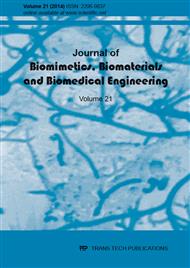[1]
Havelin, L.I., et al., The Norwegian Arthroplasty Register: 11 years and 73, 000 arthroplasties. Acta orthopaedica Scandinavica, 2000. 71(4): pp.337-53.
DOI: 10.1080/000164700317393321
Google Scholar
[2]
Ducheyne, P., et al., Structural analysis of hydroxyapatite coatings on titanium. Biomaterials, 1986. 7(2): pp.97-103.
Google Scholar
[3]
Ong, J.L., et al., Structure, solubility and bond strength of thin calcium phosphate coatings produced by ion beam sputter deposition. Biomaterials, 1992. 13(4): pp.249-54.
DOI: 10.1016/0142-9612(92)90192-q
Google Scholar
[4]
Gross, K.A., et al., Thin hydroxyapatite coatings via sol-gel synthesis. Journal of materials science. Materials in medicine, 1998. 9(12): pp.839-43.
DOI: 10.1023/a:1008948228880
Google Scholar
[5]
de Jonge, L.T., et al., Organic-inorganic surface modifications for titanium implant surfaces. Pharmaceutical research, 2008. 25(10): pp.2357-69.
DOI: 10.1007/s11095-008-9617-0
Google Scholar
[6]
Simchi, A., et al., Recent progress in inorganic and composite coatings with bactericidal capability for orthopaedic applications. Nanomedicine : nanotechnology, biology, and medicine, 2011. 7(1): pp.22-39.
DOI: 10.1016/j.nano.2010.10.005
Google Scholar
[7]
Liu, Y., G. Wu, and K. de Groot, Biomimetic coatings for bone tissue engineering of critical-sized defects. Journal of the Royal Society, Interface / the Royal Society, 2010. 7 Suppl 5: p. S631-47.
DOI: 10.1098/rsif.2010.0115.focus
Google Scholar
[8]
Yang, L., et al., The effects of inorganic additives to calcium phosphate on in vitro behavior of osteoblasts and osteoclasts. Biomaterials, 2010. 31(11): pp.2976-89.
DOI: 10.1016/j.biomaterials.2010.01.002
Google Scholar
[9]
Habibovic, P., et al., Biological performance of uncoated and octacalcium phosphate-coated Ti6Al4V. Biomaterials, 2005. 26(1): pp.23-36.
DOI: 10.1016/j.biomaterials.2004.02.026
Google Scholar
[10]
Barrere, F., et al., Biomimetic coatings on titanium: a crystal growth study of octacalcium phosphate. Journal of materials science. Materials in medicine, 2001. 12(6): pp.529-34.
Google Scholar
[11]
Canalis, E., A. Giustina, and J.P. Bilezikian, Mechanisms of anabolic therapies for osteoporosis. New England Journal of Medicine, 2007. 357(9): pp.905-916.
DOI: 10.1056/nejmra067395
Google Scholar
[12]
Barrere, F., et al., Biomimetic calcium phosphate coatings on Ti6AI4V: a crystal growth study of octacalcium phosphate and inhibition by Mg2+ and HCO3. Bone, 1999. 25(2 Suppl): p. 107S-111S.
DOI: 10.1016/s8756-3282(99)00145-3
Google Scholar
[13]
Habibovic, P., et al., Biomimetic hydroxyapatite coating on metal implants. Journal of the American Ceramic Society, 2002. 85(3): pp.517-522.
DOI: 10.1111/j.1151-2916.2002.tb00126.x
Google Scholar
[14]
Suzuki, O. and T. Anada, Synthetic octacalcium phosphate: A possible carrier for mesenchymal stem cells in bone regeneration. Conference proceedings : .. Annual International Conference of the IEEE Engineering in Medicine and Biology Society. IEEE Engineering in Medicine and Biology Society. Conference, 2013. 2013: pp.397-400.
DOI: 10.1109/embc.2013.6609520
Google Scholar
[15]
Suzuki, O., et al., Bone formation enhanced by implanted octacalcium phosphate involving conversion into Ca-deficient hydroxyapatite. Biomaterials, 2006. 27(13): pp.2671-81.
DOI: 10.1016/j.biomaterials.2005.12.004
Google Scholar
[16]
Fowler, B.O., M. Markovic, and W.E. Brown, Octacalcium Phosphate . 3. Infrared and Raman Vibrational-Spectra. Chemistry of Materials, 1993. 5(10): pp.1417-1423.
DOI: 10.1021/cm00034a009
Google Scholar
[17]
Rehman, I. and W. Bonfield, Characterization of hydroxyapatite and carbonated apatite by photo acoustic FTIR spectroscopy. Journal of Materials Science-Materials in Medicine, 1997. 8(1): pp.1-4.
DOI: 10.1023/a:1018570213546
Google Scholar
[18]
Midy, V., M. Dard, and E. Hollande, Evaluation of the effect of three calcium phosphate powders on osteoblast cells. Journal of materials science. Materials in medicine, 2001. 12(3): pp.259-65.
DOI: 10.1023/a:1008971317544
Google Scholar
[19]
Sanchez-Salcedo, S., et al., In vitro evaluation of potential calcium phosphate scaffolds for tissue engineering. Tissue engineering, 2006. 12(2): pp.279-90.
DOI: 10.1089/ten.2006.12.ft-33
Google Scholar
[20]
Ogata, K., et al., Comparison of osteoblast responses to hydroxyapatite and hydroxyapatite/soluble calcium phosphate composites. Journal of biomedical materials research. Part A, 2005. 72(2): pp.127-35.
DOI: 10.1002/jbm.a.30146
Google Scholar
[21]
Yang, F., et al., Strontium enhances osteogenic differentiation of mesenchymal stem cells and in vivo bone formation by activating wnt/catenin signaling. Stem cells, 2011. 29(6): pp.981-91.
DOI: 10.1002/stem.646
Google Scholar
[22]
Baron, R. and Y. Tsouderos, In vitro effects of S12911-2 on osteoclast function and bone marrow macrophage differentiation. European journal of pharmacology, 2002. 450(1): pp.11-7.
DOI: 10.1016/s0014-2999(02)02040-x
Google Scholar
[23]
Capuccini, C., et al., Strontium-substituted hydroxyapatite coatings synthesized by pulsed-laser deposition: in vitro osteoblast and osteoclast response. Acta biomaterialia, 2008. 4(6): pp.1885-93.
DOI: 10.1016/j.actbio.2008.05.005
Google Scholar


